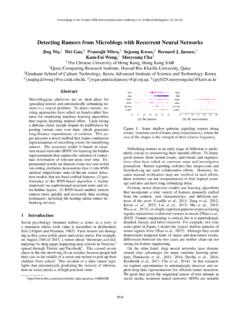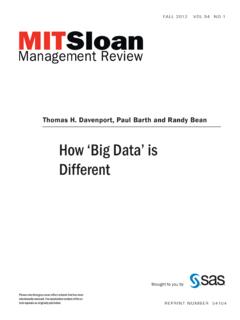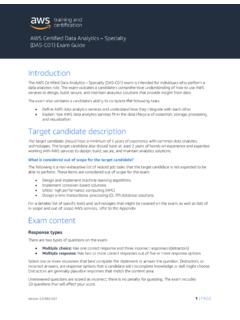Transcription of An Introduction To Geographical Information Systems (GIS)
1 An Introduction To Geographical Information Systems (GIS)by Harold ReynoldsDecember 18, 1997 Table of ContentsAn Introduction To Geographical Information Systems (GIS)..3 What is a Geographical Information System?..3 Who would use a GIS?..3 How this relates to us!..3So what's so special about geographic data ?..4So how can we store geographic data ?..4In data data can a GIS do?..7 Point-in-Polygon in Thematic and Problems Associated with the Analysis of Spatial data with a Area Units and Spatial Representation: Thematic Overall Introduction To Geographical Information Systems (GIS)What is a Geographical Information System?A Geographical Information System is a collection of spatially referenced data ( data that have locations attached to them) and the tools required to work with the data . Nowadays we normally associate the term with computers, but a (properly organized) set of file cabinets, a calculator (when available), pens, pencils, drafting table, etc.
2 , was the GIS available to people before computers. The purpose of this document is to introduce you to some of the principles behind a GIS and to discuss a few of their capabilities. Three relatively simple examples of GIS operations will be presented, with detailed instructions on how to perform them with would use a GIS?Simply put, anybody who needs to work with spatially referenced data . A small number of examples of potential users are as follows. Municipalities maintain large and complex databases that contain the street locations, building footprints, height contours, sewer lines, land use designations, and much more. Hydro and phone companies use them to record locations of their lines, both above and below ground, and for deciding where to put new ones. Geologists use them to record locations of rock formations and for use in resource prospecting operations. Anthropologists use them to record locations of current sites and perhaps to predict where new ones could be found.
3 The military maintains very large, comprehensive, and usually highly classified databases on everything that could be useful to them. And emergency services like 911 have to have a very detailed municipal address database in order to route the vehicles to the emergency as quickly as possible. Cemeteries could use a GIS to store the locations and occupants of the burial plots. Mount Pleasant Cemetery in the heart of Toronto is renowned for its collection of trees and shrubs, the locations of which could also be stored in a GIS. To my knowledge, they have not yet done so. This is not an exhaustive list!How this relates to us!We are all GIS, since we use and make decisions based on spatial data all the time. For example, the locations of your dwelling, work place, school, nearby stores, banks, and local landmarks are all included in your personal spatial database and are normally what you would think of when asked about spatial data .
4 However, don't forget the less obvious things, like computer keyboards, remote controls, locations of items in a store, and the location of your furniture (important for the 3 bathroom run).We pose questions, called queries in the jargon, to our spatial databases, like where is the nearest grocery store, how do I get there, or perhaps in idle speculation like what is the average income in Rosedale? When we move to a new part of town (or even a new town), our queries often come up blank and we have to update our neighbourhood databases with the locations of stores, bus stops, parks, and so also make decisions using spatial data , some of which are quite complex, on a daily basis. Perhaps the most common is route planning, usually from your home to some other place. This can be made more complex by your significant other calling and asking that you stop by a grocery store on the way home and pick up some broccoli for dinner.
5 If the store is significantly out of your way, you may have to adjust the route for your trip home. Others that you might not 3immediately consider include how to pack stuff in boxes and where to put the boxes in the truck, designing a flower garden, and even interior point is that a GIS is a tool we use to help us to store and manipulate large datasets and to perform complex operations that would take a human a long time (with plenty of opportunity for errors) to do. However, the algorithms and storage techniques that it uses are usually analogous to human thought processes. The purpose of this document is to explain a number of the common processes used by GIS to provide an idea of how they what's so special about geographic data ?The classic example of a database that is not spatially referenced is a telephone directory. In it are stored the subscriber's name, address and telephone number, sorted by last name. Although it contains spatial data (the address) the referencing is by the person's name.
6 You cannot use the phone book to get the numbers of everyone on your street (at least, not easily), or everyone in your biggest headache for designers and maintainers of GIS is that there are many different ways in which data can be locationally referenced. Any GIS worthy of its name should be able to handle any, or any combination, of the following types of data : Point: Addresses, elevation spot heights, locations of malls, banks, cities, volcanoes, etc. Line: Contours, geological faults, streets, highways, rivers, etc. Areas: Forests, climatic zones, lakes, soil types, land use, nations, counties, etc. Networks: Streets, highways, rivers (which are directed networks, an extra complication!) Tessellations: Census districts, postal codes, electoral boundaries. (A tessellation completely divides a region into non-overlapping areas.) Overlapping regions: Newspaper circulation areas, telephone GIS must be able to store all the data for the Geographical entities, along with whatever non-spatial attributes that are attached to them, in a way that can minimize disk file size and retrieval time.
7 Methods fall into three basic data models, or structures, described how can we store geographic data ?In LayersIn order to better organize Geographical data in a region, data that describe similar themes are stored separately. For example, a standard topographic map sheet shows contours, road networks, stream networks, power lines, forested areas, buildings, and spot heights, among other things. The descriptions for each would be stored in different files, and these are referred to as layers. The concept is analogous to drawing each on a transparency and then overlaying them at your data modelThe region of interest is divided up into small regular blocks (usually squares), with each block having a specific value attached to it. Each variable in the data set will be defined in a different layer. Even locations where the variable ( forest) is not present must be given a value, usually zero. It's easy to see that for a large area with a large number of variables, the data set can get very large very : Layer overlays are really simple, since all layers are defined with the same grid over the region.
8 Topology is implicitly defined, since the location of each cell relative to all the others can be easily : If you want to increase the resolution (that is, decrease the cell size) by a factor of two, the data set size will quadruple! In order to reduce this problem, various compression techniques, such as quadtrees and run-length encoding, are employed. Resolution is also problematic because the discretization process has an effect analogous to rounding of numbers, but in a spatial sense -- that is, what you see in the raster image is usually larger or smaller than the real-world equivalent. Objects smaller than one cell may not appear at all!Uses: All satellite and aerial photograph data come in raster form. Each pixel represents the amount of light received by the sensor at a particular wavelength at the location. All satellites collect data from more than one wavelength, so a particular satellite pass will create an instant multilayer raster map of an area, as well as business for the data storage industry.
9 Common GIS packages using the raster model are GRASS and IDRISI. Raster data are best used for representing variables that vary continuously in space, such as data ModelAll of the geographic objects of interest are described in terms of geometric elements: points, lines, polygons, and volumes if data are three-dimensional. All similar entities are grouped together and stored in different layers, as described : Much greater precision in the definition of objects is possible by defining the geometric extent of the regions in which they occur. This means that one can draw far better maps with vector data than with raster data . Much less space is required to store all the Information , since empty space on the map can be : Topology between the geometric objects must be explicitly defined, though it can be done quite efficiently. The file structures required are more complex than the raster data files, and layer overlay operations can be very complex to perform.
10 Spatial variability can be represented, using a Triangulated Irregular Network, but it is still not as effective as the use of regularly gridded data , and mathematical operations, such as derivatives, on layers or between two or more layers are all but impossible to : Very widely used in such fields as computer cartography, analysis of networks, municipal databases that contain descriptions of building footprints, streets, etc. Common GIS packages that are vector-oriented include ARC/GIS and ModelsAlso called semantic models, object-oriented models organize geographic objects into different classes, on both a general level and to more specific levels. The more specific classes inherit certain properties from their "parent" class. For example, a class called "wetland" could be a parent class of "bog", "marsh", "swamp", and "lake". Each of the subclasses would inherit properties such as area, perimeter, and streams that drain into it, from the parent : All data pertaining to each object are encapsulated within the definition of the object, which protect them better from external tampering.







